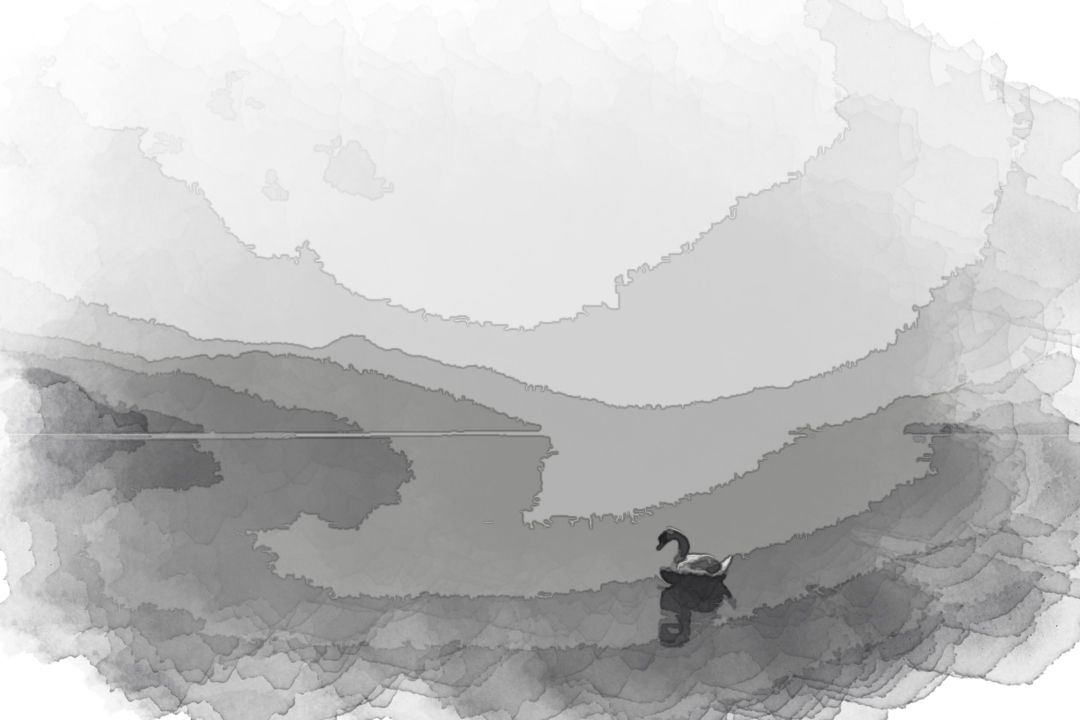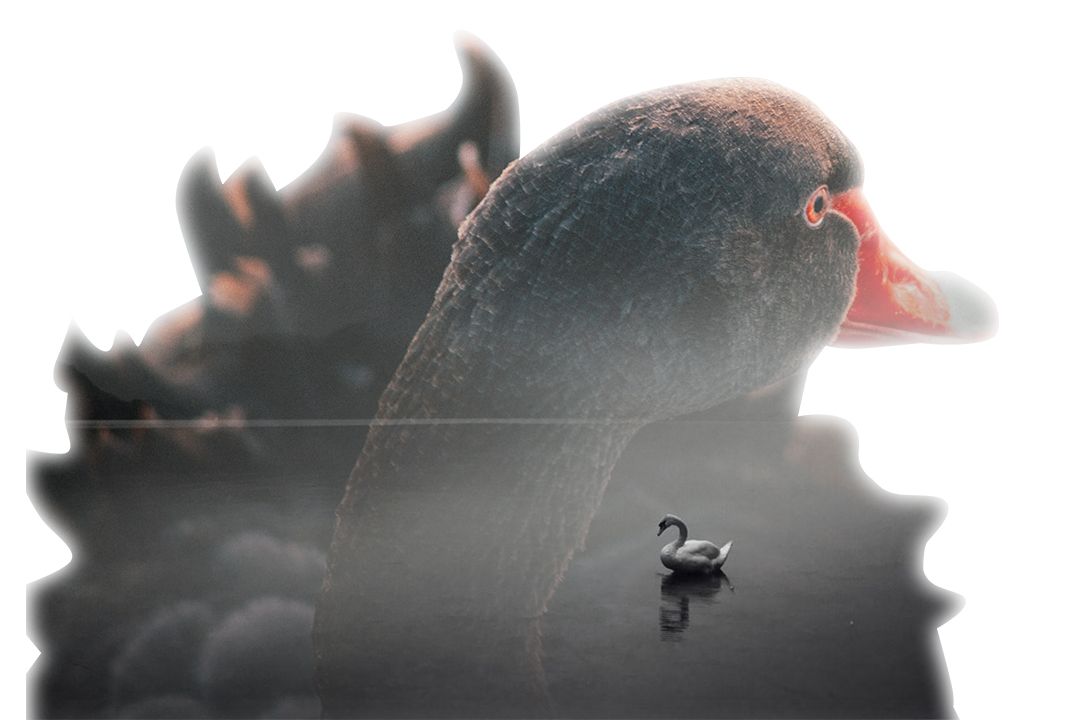No Comment

The Black Swan is Beneath Me
In the hushed embrace of pre-dawn stillness, the world unfolded in a palette of soft pastels, a serene lake reflecting the gentle dance of morning light. The canvas of nature lay before me, and within this tranquillity, a lone swan emerged as the harbinger of a profound narrative. Its graceful silhouette glided across the mirrored surface, and in that singular moment, the reality of life came into focus.
The swan, a creature of elegant poise, appeared entranced by its own shadow as if engaged in an intimate dialogue with the ethereal reflection beneath its webbed feet. This seemingly mundane act resonated with a deeper symbolism—an allegory for introspection, self-awareness, and the delicate interplay between existence and perception.
As the first rays of daylight painted the sky, the scene underwent a metamorphosis. The once vivid tableau began to fade, each detail dissolving like a cherished memory slipping through the fingers of time. The swan's silhouette, once sharply defined, melded with the undulating ripples of the water, transforming into an abstract representation of transience. It was a visual meditation on the impermanence of all things, a gentle reminder that moments, like memories, are fleeting.
In the ensuing stillness, the swan's shadow deepened, its inky blackness contrasting starkly with the softened hues of the dawn. The lake, now a canvas of reflections and shadows, seemed to hold a secret beneath its surface—a hidden depth mirrored life's enigmatic nature. In this moment of quiet revelation, it was here that the connection to a black swan event became palpable, lurking beneath the tranquil surface like an ominous undercurrent in the river of existence.
Wise men talk because they have something to say; fools, because they have to say something.
— Plato (c. 424 BC to c. 348 BC)
The words echoed in the air, resonating with the silent wisdom of the swan. It remained a silent observer, its contemplative gaze inviting introspection. The avian sage seemed to embody the essence of the quote, speaking volumes without uttering a single word, urging those who beheld it to discern the profound truths hidden beneath the surface of existence.
As the sun ascended in its majestic journey, casting a golden glow upon the landscape, the words of T.S. Eliot found their place in the unfolding narrative:
I will show you fear in a handful of dust.
— T.S. Eliot (1888-1965)
The subtle reminder of vulnerability and impermanence lingered, challenging observers to confront the ephemeral nature of their certainties. In the dance of light and shadow, the swan's presence became a reminder that even the most graceful beings are subject to the inevitable descent into the realm of dust.
The narrative continued to unfold, each moment building upon the last, creating a symphony of images and words that transcended the visual and literary boundaries. The swan, now a silent guide through the realms of contemplation, led the way to a deeper understanding of the interconnected threads of life and fate.
Once a mere backdrop to the swan's solo performance, the lake emerged as a character in its own right. It held the reflections of the world above and below, mirroring the physical reality and the intangible reflections of thoughts and emotions. With its balletic movements, the swan became a conductor orchestrating a visual and philosophical symphony, the resonance of which extended beyond the boundaries of the scene.
The progression of the image mirrored the intricate dance of life—an interplay of light and shadow, moments of clarity and obscurity, revelation and concealment. With its unwavering gaze and silent eloquence, the swan navigated this dance with grace, inviting those who bore witness to join in the contemplative journey.
As the day unfolded, the swan continued its journey across the lake, its silhouette weaving a tale of existence—a narrative painted with strokes of introspection and the ever-present awareness of the unknown. The lake, now a metaphor for the collective consciousness, reflected myriad stories and experiences, each ripple on its surface a testament to the interconnectedness of all things.
In the fading light of dusk, the swan glided toward the horizon, its silhouette blending with the twilight. The day, filled with revelation and contemplation, drew to a close. The lake, now bathed in twilight hues, held the echoes of the day's reflections, a testament to the ever-evolving tapestry of life.
In the quiet aftermath of the day's journey, the echoes of the wise men's words lingered in the air,
Wise men talk because they have something to say; fools, because they have to say something.
— Plato (c. 424 BC to c. 348 BC)
The swan, now a distant silhouette against the night canvas, seemed to nod in silent agreement. It had spoken through its elegant movements, imparting a profound truth—a reminder that wisdom often resides in the spaces between words and the silent contemplation of the mysteries surrounding us.
As the night enveloped the landscape, the words of T.S. Eliot found a final resonance,
I will show you fear in a handful of dust.
— T.S. Eliot (1888-1965)
The swan, now a mere shadow against the starlit sky, became a living embodiment of the transient nature of life. The fear in a handful of dust was not a paralyzing terror but a gentle acknowledgment of the fragile beauty in every fleeting moment.
In the tapestry of time, the swan's journey had become a timeless story. This visual poem unfolded with the grace of a ballet and the profundity of a philosophical discourse. The lake, now a reflective pool of collective consciousness, held the imprints of the day's revelations, inviting those who dared to gaze upon its surface to contemplate the delicate dance of existence.
And so, the short story, like the swan's graceful glide across the lake, ended, leaving a lingering sense of wonder and contemplation. The progression of the image, from the focused moment of the swan's introspection to the fading memories and the ominous shadow beneath the surface, became a metaphor for the human experience—a journey through light and shadow, wisdom and folly, fear and transcendence. In the end, with its silent presence, the swan invited us to embrace the ever-unfolding narrative of life, navigate the dance with grace, and find wisdom not only in spoken words but also in the eloquent silence of contemplation.

The planksip Writers' Cooperative is proud to sponsor an exciting article rewriting competition where you can win over $750,000 in prize money.
Figures of Speech Collection Personified
Our editorial instructions for your contest submission are simple: incorporate the quotes and imagery from the above article into your submission.
What emerges is entirely up to you!
Winners receive $500 per winning entry multiplied by the article's featured quotes. Our largest prize is $8,000 for rewriting the following article;

At planksip, we believe in changing the way people engage; at least, that's the Idea (ἰδέα). By becoming a member of our thought-provoking community, you'll have the chance to win incredible prizes and access our extensive network of media outlets that will amplify your voice as a thought leader. Your membership truly matters!


